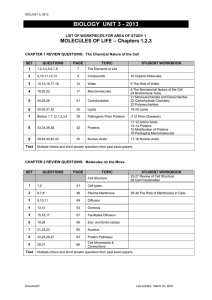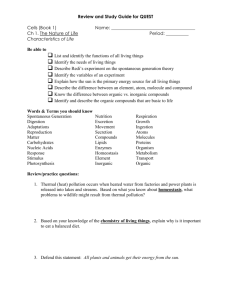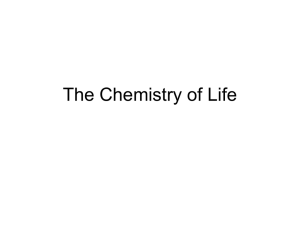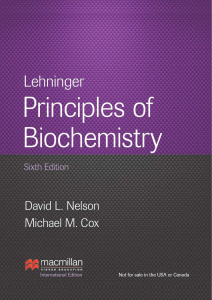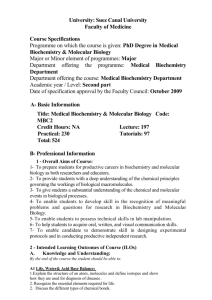Reviewing the integration of Biochemical aspects in the Modules of
advertisement
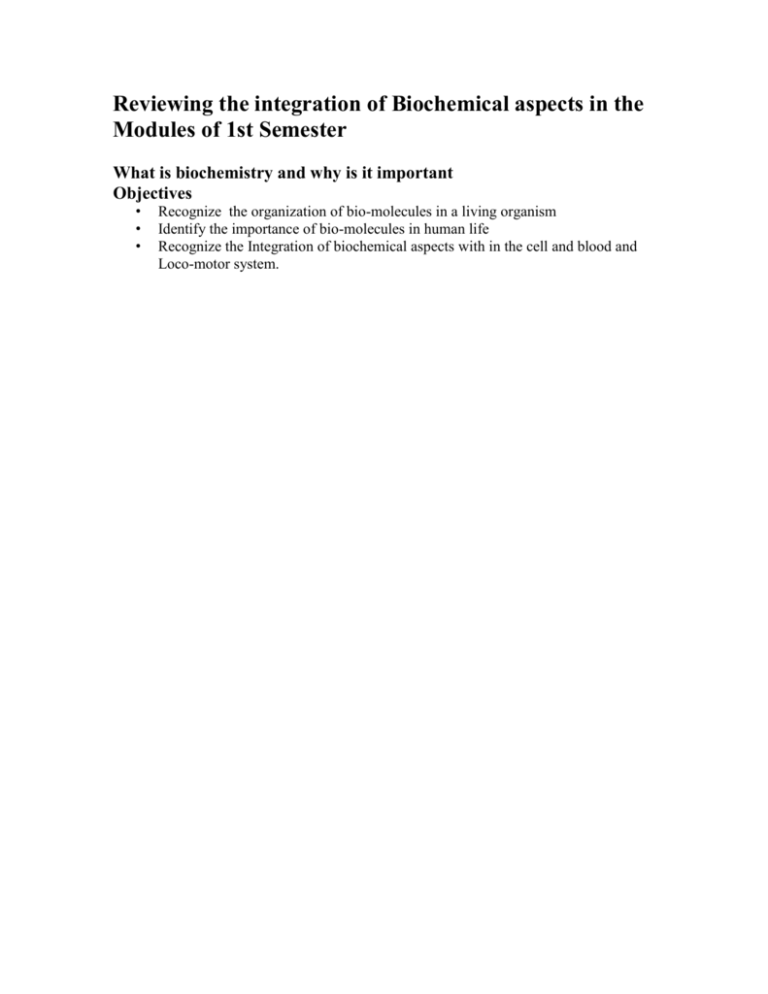
Reviewing the integration of Biochemical aspects in the Modules of 1st Semester What is biochemistry and why is it important Objectives • • • Recognize the organization of bio-molecules in a living organism Identify the importance of bio-molecules in human life Recognize the Integration of biochemical aspects with in the cell and blood and Loco-motor system. Biochemical Organization in the living Organisms • • • • Elements– C, N, S, Fl, …… Molecules- H2O, CH4 Macro molecules ---- Bio-molecules Biomolecule: – Major Classes of Biomolecule (Functional Groups) – Carbohydrates, Lipids, Proteins, vitamins, Hemoglobin, etc Organization of elements in to…. molecules, macromolecules, cells,……… • Biochemical Organization in Order is necessary for life : How Biochemical Reactions, Energy, Metabolism, Respiration, Digestion, Genetic Information Processing, The Living World • All living species are composed of prokaryotic or eukaryotic cells. • Living organisms are classified in to three domains: 1. bacteria 2. archaea 3. eukarya All cells contain… • Water, 80% • Proteins, 12% • Carbohydrates • Nucleic Acids 3% combined • Vitamins • Lipids, 3% • Salts & minerals, 2% • Note: the body contains more water outside the cell. Chemistry of Life Outline Properties of Water A. Cohesion, Adhesion, and Surface Tension B. Temperature Effects C. Solvent Properties II. Acids and Bases A. Properties B. pH Scale C. Buffers D. Salts Water • Where it is in our body? Water Distribution: • What is the importance of water? Fluid compartments: Intracellular, Extra cellular – ECF: heterogeneous Plasma Interstitial and Lymph fluid Fluid of dense connective tissue, cartilage ,bones Tran cellular fluid – Collection foremost by the transport or secretary. a. In salivary glands, pancreas, liver, and biliary tract, skin, mucous of respiratory tract & GIT. b. Fluids present in spaces within the - eyes (aqueous humor) - CSF in spiral card, ventricles of brain - with lumen of the GIT Normal Water Balance • Intake of water – Water drunk in response of thirst. – Water along with food within there molecules – Metabolic water – Produced from Oxidation of food each grain of CHO – 0.56 ml – Fats – 1.07 ml • Protein of water 0.34 ml of water on complete oxidation – In general 10-15 ml of water are produced per 100 calories of energy produced Loss • Normally in health, the intake of water is more than the loss via skin, lungs and feaces and the surplus is excreted by the kidney. Proteins • • • Definition Classification Importance Amino acids link to form proteins. Amino acids are the building blocks of life! There are only 20 amino acids working in human body. There are, however, an infinite number of proteins that can be formed. Lipids • Definition • Classification • Importance • All fats provide necessary insulation, lubrication, and flexibility of an organism’s cells Carbohydrates • • • Definition Classification Importance Basic source of energy (contains hydrogen, carbon, and oxygen) , Classified in to Monosaccharide, Disaccharides, oligo and polysaccharides on the basis of sugar components. Examples: Sugars (glucose), Starches (storage of glucose), Cellulose (cell walls) • When glucose if broken, ATP is released ATP is ENERGY for the cell Vitamins • • • Definition Classification Importance Nucleic Acids • Definition • Classification • Importance Large molecules that function in genetics. Two types DNA (Deoxyribose Nucleic Acid) RNA (Ribonucleic Acid) Three functions Pass information on to the next generation Make proteins Control all cell functions Enzymes • • • Definition Classification Function are proteins that speed up specific reactions in cells. Activation Energy: Energy needed to start a reaction Catalyst: Compound that speed up reactions without being changed during the reaction. Enzymes act as a catalyst by lowering the activation energy of a biochemical reaction. Minerals • • • Definition Classification Importance Biochemical components of Cell Working biochemistry of Blood • • • • • • Hemoglobin : Structure and function Synthesis Degradation Thalasemia Hemoglobinopathies Blood Investigations Biochemical aspects of Musculoskeletal system • • Chemical Composition of Bones Role of chemical components during muscle contractions Conclusion • Biochemistry is use less and not important for life
